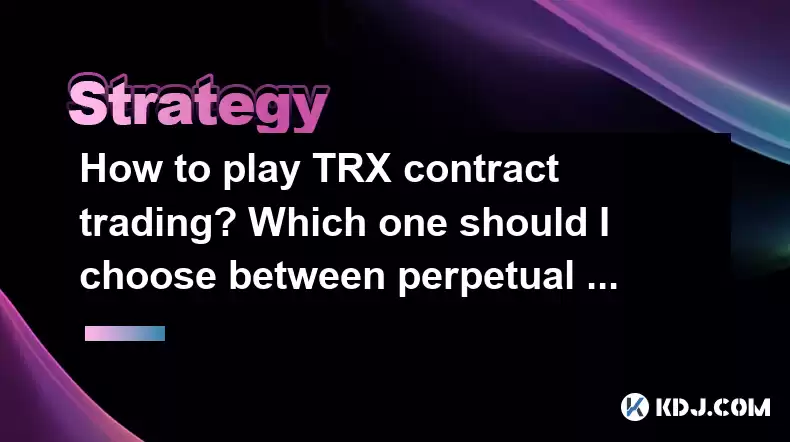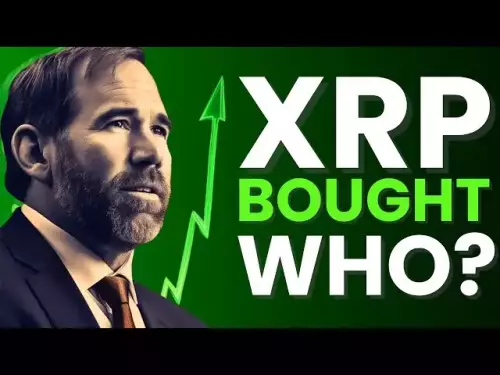-
 bitcoin
bitcoin $108842.957301 USD
-1.88% -
 ethereum
ethereum $3931.777121 USD
-1.66% -
 tether
tether $1.000186 USD
-0.03% -
 bnb
bnb $1153.250882 USD
-2.20% -
 xrp
xrp $2.367904 USD
-1.94% -
 solana
solana $186.182050 USD
-4.20% -
 usd-coin
usd-coin $0.999997 USD
0.00% -
 tron
tron $0.316949 USD
-1.00% -
 dogecoin
dogecoin $0.190780 USD
-3.12% -
 cardano
cardano $0.651324 USD
-2.67% -
 hyperliquid
hyperliquid $37.141055 USD
-0.85% -
 ethena-usde
ethena-usde $0.999224 USD
-0.09% -
 chainlink
chainlink $17.579031 USD
-2.47% -
 bitcoin-cash
bitcoin-cash $509.426284 USD
-2.79% -
 stellar
stellar $0.315298 USD
-2.93%
How to play TRX contract trading? Which one should I choose between perpetual contract and delivery contract?
TRX contract trading offers perpetual and delivery contracts, allowing traders to speculate on TRON's price movements with different strategies and risk levels.
Apr 28, 2025 at 10:28 pm

Introduction to TRX Contract Trading
TRX contract trading is a popular way for traders to speculate on the price movements of TRON (TRX), the native cryptocurrency of the TRON blockchain. This form of trading involves entering into agreements to buy or sell TRX at a future date or within a specific timeframe. There are two main types of TRX contracts: perpetual contracts and delivery contracts. Each type offers different features and benefits, which can cater to various trading strategies and risk appetites.
Understanding Perpetual Contracts
Perpetual contracts, also known as perpetual futures, are a type of derivative that allows traders to speculate on the price of TRX without an expiration date. These contracts are designed to mimic the spot price of TRX, and they can be held indefinitely. One of the key features of perpetual contracts is the funding rate, which ensures the contract price stays close to the underlying asset's spot price.
- To trade a perpetual contract on TRX, follow these steps:
- Choose a reputable exchange that offers TRX perpetual contracts, such as Binance or BitMEX.
- Create an account if you do not have one already, and complete the necessary KYC (Know Your Customer) verification.
- Deposit funds into your account, ensuring you have enough margin to cover your trades.
- Navigate to the TRX perpetual contract trading section on the exchange.
- Select your leverage level, which determines the amount of borrowed funds you can use to amplify your trading position.
- Place your order by specifying whether you want to go long (buy) or short (sell) and setting your entry price.
- Monitor your position and manage it according to your trading strategy, including setting stop-loss and take-profit orders to manage risk.
Understanding Delivery Contracts
Delivery contracts, also known as futures contracts, have a set expiration date at which the contract must be settled. These contracts require the buyer to purchase and the seller to sell the underlying asset (TRX) at the agreed-upon price on the expiration date. Delivery contracts can be used for hedging or speculative purposes.
- To trade a delivery contract on TRX, follow these steps:
- Select an exchange that offers TRX delivery contracts, such as OKEx or Huobi.
- Sign up for an account and complete the required verification processes.
- Fund your account with the necessary margin to initiate your trades.
- Access the TRX delivery contract section on the exchange platform.
- Choose the contract expiration date that aligns with your trading strategy.
- Decide on your position (long or short) and the contract size.
- Enter your order at the desired price and monitor it until the contract expires.
- Settle the contract at expiration, either by taking delivery of the TRX or settling in cash, depending on the exchange's rules.
Comparing Perpetual and Delivery Contracts
When deciding between perpetual contracts and delivery contracts for TRX trading, several factors should be considered:
- Time Horizon: Perpetual contracts are suitable for traders who want to maintain a position over an extended period without worrying about expiration. Delivery contracts are better for those with a specific time frame in mind.
- Liquidity: Perpetual contracts generally have higher liquidity due to their popularity and continuous nature. Delivery contracts may have lower liquidity, especially for longer-dated contracts.
- Funding and Settlement: Perpetual contracts involve funding rates that can either be paid or received, depending on the market conditions. Delivery contracts do not have funding rates but require settlement at expiration.
- Risk Management: Both types of contracts allow for leverage, but perpetual contracts can be more volatile due to the funding mechanism. Delivery contracts provide a clear end date, which can help in planning and managing risk.
Choosing the Right Contract for Your Strategy
Selecting the appropriate contract type depends on your trading goals and risk tolerance. If you are looking to hold a position for an indefinite period and want to benefit from high liquidity, perpetual contracts might be the better choice. They allow for more flexibility and can be adjusted according to market movements without the pressure of an expiration date.
On the other hand, if you have a specific date in mind for your trade or want to hedge against future price movements of TRX, delivery contracts could be more suitable. They provide a structured approach to trading with a clear settlement date, which can be beneficial for planning and executing strategies that rely on precise timing.
Practical Considerations and Tips
When engaging in TRX contract trading, it's essential to consider several practical aspects to enhance your trading experience:
- Risk Management: Always use stop-loss orders to limit potential losses. Understand the leverage you are using and never risk more than you can afford to lose.
- Market Analysis: Stay informed about the latest developments in the TRON ecosystem and broader cryptocurrency market. Use technical and fundamental analysis to make informed trading decisions.
- Platform Familiarity: Spend time getting to know the trading platform you are using. Familiarize yourself with the interface, order types, and any specific features that can aid your trading.
- Continuous Learning: The cryptocurrency market is dynamic, and staying updated with new strategies and tools can give you an edge in TRX contract trading.
Frequently Asked Questions
Q: Can I switch between a perpetual contract and a delivery contract once I have entered a position?A: No, once you have entered a position in either a perpetual or delivery contract, you cannot switch between the two types. You would need to close your current position and open a new one in the desired contract type.
Q: What happens if I hold a delivery contract until expiration and do not have enough funds to settle it?A: If you do not have sufficient funds to settle a delivery contract at expiration, the exchange will typically liquidate your position to cover the shortfall. This can result in significant losses, so it's crucial to manage your margin levels carefully.
Q: Are there any fees associated with TRX contract trading?A: Yes, exchanges charge various fees for TRX contract trading, including trading fees, funding fees for perpetual contracts, and settlement fees for delivery contracts. Always check the fee structure of the exchange you are using to understand the costs involved.
Q: Can I trade TRX contracts on weekends and holidays?A: Yes, most exchanges that offer TRX contract trading operate 24/7, allowing you to trade on weekends and holidays. However, liquidity might be lower during these times, which can affect the execution of your trades.
Disclaimer:info@kdj.com
The information provided is not trading advice. kdj.com does not assume any responsibility for any investments made based on the information provided in this article. Cryptocurrencies are highly volatile and it is highly recommended that you invest with caution after thorough research!
If you believe that the content used on this website infringes your copyright, please contact us immediately (info@kdj.com) and we will delete it promptly.
- Upbit Listing Sparks Altcoin Frenzy: What's Next for Bitcoin?
- 2025-10-17 14:25:14
- Gold, Bitcoin, and Digital Assets: A New Yorker's Take on the Future of Finance
- 2025-10-17 14:25:14
- Pi Network: Pioneering a New Era of Crypto Collaboration within the Crypto Community and Blockchain Technology
- 2025-10-17 14:30:01
- Crypto Updates, FxWirePro, Key Updates: Staying Ahead in the Digital Frontier
- 2025-10-17 14:30:01
- Bitcoin's Fear Dip: A Golden Opportunity to Accumulate?
- 2025-10-17 14:45:11
- Bitcoin, Recession Fears, and Gold's ATH: A New Yorker's Take
- 2025-10-17 14:30:01
Related knowledge

Practical parameter settings for a Bitcoin multi-timeframe moving average system
Sep 18,2025 at 10:54pm
Optimizing Timeframe Combinations for Bitcoin Trading1. Selecting appropriate timeframes is crucial when building a multi-timeframe moving average sys...

How can I filter out false breakouts in Dogecoin high-frequency trading?
Sep 22,2025 at 01:00am
Understanding False Breakouts in Dogecoin Trading1. A false breakout occurs when Dogecoin's price appears to move beyond a defined support or resistan...

Techniques for identifying tops and bottoms in the Bitcoin on-chain NVT model
Sep 20,2025 at 07:54pm
Understanding the NVT Model in Bitcoin Analysis1. The Network Value to Transactions (NVT) ratio is often described as the 'P/E ratio' of the cryptocur...

What does the surge in open interest in Bitcoincoin futures mean?
Sep 20,2025 at 11:18pm
Understanding the Surge in Dogecoin Futures Open Interest1. A surge in open interest within Dogecoin futures indicates a growing number of active cont...

How can I use the Ethereum USDT premium to gauge market sentiment?
Sep 18,2025 at 11:55pm
Understanding the Ethereum USDT Premium1. The Ethereum USDT premium refers to the price difference between USDT (Tether) traded on Ethereum-based plat...

What should I do if Ethereum staking yields decline?
Sep 20,2025 at 06:18am
Understanding the Causes Behind Declining Ethereum Staking Yields1. The Ethereum network transitioned to a proof-of-stake consensus mechanism with the...

Practical parameter settings for a Bitcoin multi-timeframe moving average system
Sep 18,2025 at 10:54pm
Optimizing Timeframe Combinations for Bitcoin Trading1. Selecting appropriate timeframes is crucial when building a multi-timeframe moving average sys...

How can I filter out false breakouts in Dogecoin high-frequency trading?
Sep 22,2025 at 01:00am
Understanding False Breakouts in Dogecoin Trading1. A false breakout occurs when Dogecoin's price appears to move beyond a defined support or resistan...

Techniques for identifying tops and bottoms in the Bitcoin on-chain NVT model
Sep 20,2025 at 07:54pm
Understanding the NVT Model in Bitcoin Analysis1. The Network Value to Transactions (NVT) ratio is often described as the 'P/E ratio' of the cryptocur...

What does the surge in open interest in Bitcoincoin futures mean?
Sep 20,2025 at 11:18pm
Understanding the Surge in Dogecoin Futures Open Interest1. A surge in open interest within Dogecoin futures indicates a growing number of active cont...

How can I use the Ethereum USDT premium to gauge market sentiment?
Sep 18,2025 at 11:55pm
Understanding the Ethereum USDT Premium1. The Ethereum USDT premium refers to the price difference between USDT (Tether) traded on Ethereum-based plat...

What should I do if Ethereum staking yields decline?
Sep 20,2025 at 06:18am
Understanding the Causes Behind Declining Ethereum Staking Yields1. The Ethereum network transitioned to a proof-of-stake consensus mechanism with the...
See all articles










































































